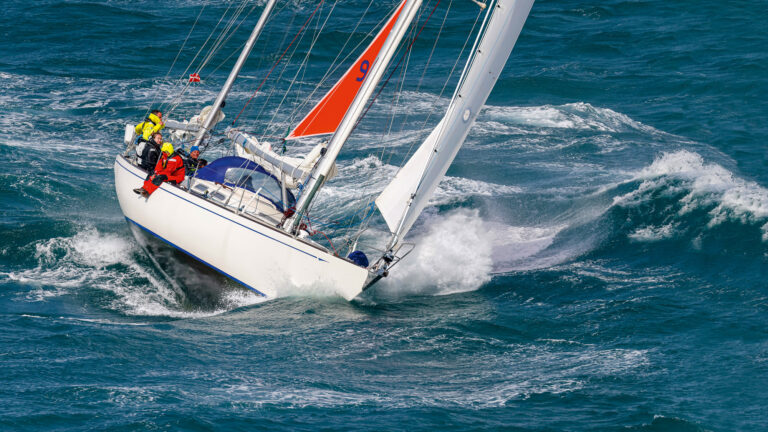What Is A Knockdown In Sailing
So, you’re out on the open water, sailing along, enjoying the wind in your hair and the thrill of the waves beneath you. But suddenly, the wind shifts, and before you know it, your perfectly stable sailboat is leaning dangerously to one side.
This, my friend, is what we call a knockdown in sailing. In simple terms, it’s when your boat gets heeled over by a sudden gust of wind, putting you at risk of capsizing.
It’s a heart-stopping moment that requires quick thinking and skilled maneuvering to regain control. But fear not, because in this article, we’ll be exploring what exactly a knockdown is, the causes behind it, and how to prevent and recover from one.
So sit tight and let’s navigate through the ins and outs of knockdowns in sailing.

Defining a Knockdown
Fundamental understanding of a knockdown
A knockdown in sailing refers to a situation where a boat is forcefully tipped over to one side by external forces, such as strong winds, big waves, or improper sail positioning.
This sudden shift in balance can cause the boat to lean over at a significant angle, sometimes even to the point of the mast touching the water.
It is important to note that a knockdown does not necessarily result in a complete capsize, though it can be a precursor to more severe incidents if not properly managed.
Distinction from other sailing terms
It is crucial to differentiate a knockdown from other sailing terms that describe similar situations. While a knockdown involves the forceful heeling of the boat due to external factors, a capsize occurs when the boat completely overturns and ends up upside down in the water.
Another sailing term to be aware of is broaching, which refers to the loss of control of the boat and its sudden turning in the direction of the waves. Understanding these distinctions is essential for accurate communication and proper response in sailing scenarios.
Causes of a Knockdown
Effect of strong winds
Strong winds are one of the primary causes of knockdowns in sailing. When the wind blows forcefully against the sails, it creates a lot of pressure and can quickly push the boat over to one side.
This is particularly common when sailing upwind and encountering gusts of wind. It is important to be aware of the wind conditions and to adjust the sails accordingly to prevent excessive heeling and potential knockdowns.
Implications of big waves
Big waves also play a significant role in causing knockdowns. When sailing in rough seas, large waves can crash against the side of the boat, creating a destabilizing force.
This, combined with the already existing wind pressure, can lead to a knockdown. Waves can also cause the boat to pitch and roll, further increasing the risk of losing control.
Understanding wave patterns and adjusting course or sail plan accordingly can help minimize the risk of knockdowns in such conditions.
Positioning of the sails
Improper positioning of the sails can contribute to the occurrence of a knockdown. When the sails are not trimmed correctly, or their angle concerning the wind is off, it can create an imbalance and increase the likelihood of the boat heeling excessively.
Proper sail handling and regular adjustments based on wind direction and strength are key to maintaining balance and stability.
Weight distribution within the boat
The distribution of weight within the boat also plays a crucial role in preventing knockdowns. If too much weight is on one side of the boat, it can cause the boat to list and potentially capsize.
Properly distributing the weight evenly across the boat, especially in response to changing wind and wave conditions, helps maintain stability and reduces the risk of knockdowns.
Different Types of Knockdowns
Capsizing
Capsizing is the most severe form of knockdown, where the boat completely turns over and ends up upside down in the water. This often occurs when the boat is hit by strong gusts of wind or when waves overcome the boat’s stability.
Capsizing can be a dangerous situation, especially if crew members are trapped beneath the overturned boat. Prompt action and proper training are necessary to safely recover from a capsized boat.
Pitchpoling
Pitchpoling refers to a form of knockdown where the boat’s bow dives through a wave, causing the boat to flip over end over end. This type of knockdown is particularly common in highly maneuverable boats, such as dinghies or small racing boats.
Pitchpoling can be caused by excessive speed, improper sail handling, or misjudgment of wave conditions.
Broaching
Broaching occurs when a boat loses control and rapidly turns sideways to the waves. The boat can quickly tip over and be at risk of further knockdown or capsize.
Broaching is often caused by a combination of factors, such as improper sail trim, steering errors, or encountering breaking waves. It is crucial to quickly regain control and steer the boat back into a safe position to prevent a more severe incident.
Death roll
The term “death roll” refers to a knockdown that results in an extremely violent and rapid overturning of the boat. This type of knockdown is typically associated with large keelboats or racing yachts, where the boat suddenly rolls over despite the crew’s efforts to control the situation.
Death rolls are often caused by a combination of strong winds, high-speed sailing, and unfavorable sea conditions. It is a highly dangerous situation that requires immediate action to ensure the safety of everyone on board.
The Impact of a Knockdown
Potential damage to the boat
A knockdown can result in various forms of damage to the boat. The forceful heeling and potential capsize put significant stress on the structure, rigging, and equipment of the vessel.
Components such as the mast, sails, hull, and rigging can be damaged or even destroyed during a knockdown.
It is essential to conduct a thorough inspection of the boat after a knockdown to assess any potential damage and take appropriate measures for repairs or replacements.
Risk of overboard passengers
A knockdown poses a serious risk of passengers being thrown overboard. As the boat tilts and potentially capsizes, individuals on deck can be swept off by the force of the water.
This is especially dangerous if passengers are not wearing proper safety gear, such as life jackets or harnesses. Keeping a vigilant lookout for crew members and implementing safety protocols, such as tether lines, greatly reduces the risk of passengers going overboard during a knockdown.
Hull and mast damage
The hull and mast are particularly susceptible to damage during a knockdown. The impact of the boat hitting the water or the force exerted on the mast as it touches the water can cause structural damage or complete failure.
In some cases, the mast may snap or the hull may develop cracks or leaks. Proper maintenance, regular inspections, and reinforced construction materials can help mitigate the potential damage to these critical components.

Preventing a Knockdown
Safe handling of the boat
Safe and responsible boat handling is essential in minimizing the risk of a knockdown. This includes maintaining proper speed, avoiding sudden changes in course or sail trim, and being aware of the boat’s heel angle.
Being attentive to the boat’s response and adapting sail trim and steering accordingly helps maintain balance and control. It is crucial to stay within the boat’s design and stability limits to prevent excessive heeling that could lead to a knockdown.
Proper use of the sails
Properly using the sails is key to preventing knockdowns. This involves adjusting the sail plan based on wind conditions, such as reefing or depowering the sails in strong winds.
Maintaining a balanced sail trim and keeping the sails flat helps reduce the heeling force and increases the boat’s stability. Regularly monitoring and adjusting the sail settings as the wind and sea conditions change is vital for preventing knockdowns.
Monitoring and responding to weather conditions
Constantly monitoring weather conditions is essential in preventing knockdowns. Paying attention to weather forecasts, wind patterns, and wave heights helps sailors anticipate potential risks and take appropriate precautions.
Avoiding sailing in extreme conditions, such as during severe storms or when high winds and large waves are expected, significantly reduces the chances of a knockdown.
Developing the ability to read the signs of changing weather and making informed decisions based on that information is crucial for safe sailing.
Procedures Following a Knockdown
Safety procedures
Immediately following a knockdown, it is essential to prioritize the safety of everyone on board. Ensuring that all crew members are accounted for and have not been injured or thrown overboard is the first step.
If anyone is missing, prompt search and rescue procedures must be initiated. It is important to remain calm and organized while executing safety protocols to minimize panic and facilitate effective communication among the crew.
Assessing and managing damage
After ensuring the crew’s safety, assessing the boat’s condition is crucial. This involves inspecting the hull, mast, rigging, sails, and any other components for potential damage.
If there are leaks, cracks, or any other structural issues, proper repairs or temporary fixes should be implemented to prevent further damage. Having a basic knowledge of boat maintenance and repair techniques is invaluable in such situations.
Resuming control of the boat
Once the crew’s safety has been ensured and initial damage assessment conducted, efforts should be made to regain control of the boat.
Depending on the severity of the knockdown, this may involve righting the boat if it has capsized, adjusting the sail plan, or implementing corrective steering maneuvers.
The ability to quickly recover from a knockdown and resume sailing relies on effective teamwork, clear communication, and the crew’s experience and training.
Emergency Tools and Devices
Life jackets and harnesses
Life jackets and harnesses are crucial safety equipment that should be worn by all individuals on board during sailing.
In the event of a knockdown, these devices help keep individuals afloat and attached to the boat, reducing the risk of drowning or being swept away. It is important to regularly inspect and maintain life jackets and harnesses to ensure their effectiveness in emergencies.

VHF radio and flares
A VHF radio is an essential communication tool for sailors to contact the Coast Guard or nearby vessels in case of emergencies, including knockdowns. It allows for quick and effective communication of distress signals and enables coordination of rescue efforts.
Flares are also important signaling devices to attract attention and indicate the boat’s location when visual sight is limited. Familiarity with the operation of these devices is vital for effective use during emergencies.
GPS and distress beacons
GPS devices provide accurate positioning information, aiding in navigation and assisting in emergencies. They allow the crew to relay their precise location to rescue teams, facilitating a faster response.
Distress beacons, such as Emergency Position Indicating Radio Beacons (EPIRBs), transmit distress signals to satellites, alerting search and rescue organizations.
Having these devices onboard and knowing how to use them correctly significantly improves the chances of a successful rescue.
First aid kit
A well-stocked first aid kit is a must-have onboard any boat. In the event of a knockdown, injuries may occur and immediate medical attention may be required.
A comprehensive first aid kit should contain supplies to treat common injuries, such as cuts, burns, fractures, and sea sickness.
Having crew members trained in basic first aid and familiar with the contents and usage of the first aid kit is essential for providing prompt and effective medical assistance.
Instruction and Training
Importance of sailing courses
Participating in sailing courses and training programs is highly beneficial for sailors of all levels of experience. These courses provide valuable theoretical knowledge and practical skills necessary for safe and enjoyable sailing.
Professional instructors teach students about the fundamentals of boat handling, safety procedures, weather management, and response to emergencies such as knockdowns.
Engaging in continuous education helps sailors develop the necessary skills and confidence to prevent and properly manage knockdowns.
Learning to anticipate and avoid knockdowns
One of the key skills sailors must develop is the ability to anticipate and avoid knockdowns. This involves recognizing the signs of an impending knockdown, such as increasing wind strength or changes in wave patterns.
By continually monitoring these indicators and making appropriate adjustments to sail plan and course, sailors can prevent the boat from reaching a critical tipping point.
Anticipation and proactive decision-making play a significant role in maintaining a safe sailing environment.
Recovery techniques training
Training in recovery techniques is critical for sailors to effectively respond to knockdowns. Learning various methods of righting a capsized boat, regaining control, and returning to a stable sailing position is essential for a quick recovery.
These techniques are typically taught in specialized training programs and simulate real-life knockdown scenarios.
Practicing these recovery techniques in a controlled environment improves the crew’s ability to respond effectively and confidently during actual knockdown incidents.
Sailing Insurance and Knockdowns
Financial protection from damages
Sailing insurance provides financial protection in the event of damage or loss to the boat, equipment, or personal belongings. This coverage can help alleviate the financial burden associated with repairing or replacing damaged components resulting from a knockdown.
Having a comprehensive insurance policy for sailing activities ensures that sailors can focus on their safety and recovery rather than the potential financial consequences of a knockdown.
Insurance policy coverage on knockdowns
When considering sailing insurance, it is important to carefully review the policy to understand the specifics of coverage related to knockdown incidents. Different insurance policies may have varying limitations or exclusions concerning knockdowns and the resulting damage.
Some policies may cover the costs of repairs and replacements directly related to a knockdown, while others may exclude such incidents or have specific deductibles. Reading the policy in detail and discussing any uncertainties with the insurance provider are important steps in understanding the coverage.
Claim processing after a knockdown
In the unfortunate event of a knockdown, it is important to understand the claim process associated with sailing insurance. Immediately after the incident, it is crucial to gather and document evidence of the damages, such as photographs, written narratives, and witness statements.
Contacting the insurance provider as soon as possible and providing them with all the necessary information helps expedite the claim processing. Cooperation throughout the process, including providing requested documentation and attending inspections, ensures a smoother resolution.
Personal Experiences and Stories
First-person narratives of knockdowns
Listening to and learning from the first-person narratives of sailors who have experienced knockdowns can provide valuable insights and lessons learned.
Hearing about their accounts, the challenges they faced, and how they managed to recover from the knockdowns can help others better understand the risks and potential consequences.
These narratives often emphasize the importance of preparedness, quick decision-making, and effective teamwork in overcoming knockdown situations.
Lessons learned from experienced sailors
Experienced sailors who have encountered knockdowns often have valuable wisdom to share. Their knowledge and insights gained from extensive time at sea can help educate others on the potential causes, preventive measures, and recovery techniques associated with knockdowns.
Learning from the experiences of those who have navigated through such challenging situations can greatly enhance sailors’ understanding and preparedness to effectively respond to knockdown incidents.
How Knockdown Experiences Influence Future Sailing Practices
Experiencing a knockdown firsthand can have a profound impact on sailors’ future practices and approach to sailing. The lessons learned in managing the stress, fear, and potential dangers during a knockdown shape sailors’ decision-making, risk assessment, and adherence to safety protocols.
These experiences often reinforce the importance of proper training, continuous learning, and ongoing vigilance in maintaining a safe and enjoyable sailing experience.








